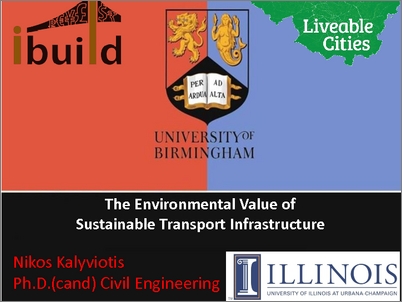Browse by Series/Collection
Group by: No Grouping | No Grouping Number of items: 1. The Environmental Value of Sustainable Transport InfrastructureThe climate change threat to humanity challenges the creation of sustainable transport infrastructure based on the triptych of balancing and maximising environmental, economic and social value. A piece of infrastructure may be created in a sustainable manner, but may be then subsequently used unsust... [ more ] The climate change threat to humanity challenges the creation of sustainable transport infrastructure based on the triptych of balancing and maximising environmental, economic and social value. A piece of infrastructure may be created in a sustainable manner, but may be then subsequently used unsustainably, that would not be sustainable. In other words, sustainable transport infrastructure is linked with the use of the most sustainable transport choices. Environmental value may be defined by the natural and anthropogenic factors and elements which interact with and influence the natural ecosystem, quality of life, and human health and well-being. Emissions are a widely accepted way by the Food and Agriculture Organization of the United Nations to “calculate” environmental damaging actions. Emissions address the production of pollutants and the placement of waste into the environment. The target is to reduce the use of transport modes with high environmental impact (e.g. cars) and replace them with transport modes with low or no environmental impact (e.g. public transport, walking, cycling). The hypothesis tested is that each individual should be able to understand which transport mode is the most sustainable and investigate whether each individual will accept the use of alternative options that consume less energy and generate fewer emissions. The methodology used was statistical inference. The hypothesis regarding the individuals’ understanding was verified with some deviations and a table with the environmental infrastructure interdependencies was developed based on EXIOBASE 3 database using the emissions generated from each transport sector for comparison purposes. | Author : Kalyviotis, Nikolaos and Rogers, Chris DF and Tight, Miles R. and Hewings, Geoffrey J.D. and Doloi, Hemanta Date : 2018 Source : 11th annual Midwest Graduate Student Summit on Applied Economics, Regional, and Urban Studies (AERUS), 7–8 April 2018, West Virginia University, Morgantown, West Virginia, United States of America. Keywords : Environment, Transport management, Infrastructure planning Collection : 11th annual Midwest Graduate Student Summit on Applied Economics, Regional, and Urban Studies (AERUS) | ![[img]](/3206/1.hassmallThumbnailVersion/Presentantion_%2D_Illinois2.pdf)  Preview |
|
|
This list was generated on Fri Jul 26 01:45:23 2024 IST. |

